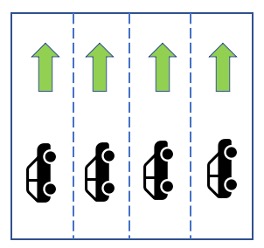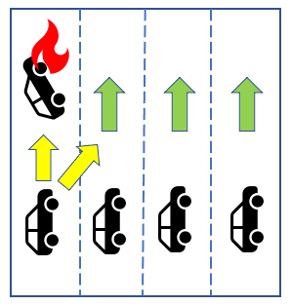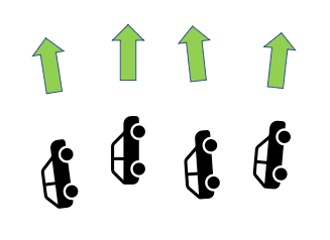I was once at an organization that had multiple acronym-based culture programs such as “CARE,” “LEAD,” “SUPPORT,” and whatnot. These programs came with marketing flyers that were frequently found near or in elevators and sometimes by drinking fountains. More impactful to day-to-day operations in my division, however, was another phrase that entered usage after a seismic change in upper management that introduced a culture program of its own: Stay In Your Lane.
That phrase translates roughly to “do your job and let others do theirs” which isn’t crazy. The use in our division, though, was intended to stifle troublesome question-asking (i.e., that isn’t a question you or anyone else should be asking), and to tell people they mis-stepped but without stating where any lane lines actually were. This new messaging was unfortunate because that behavior ran contrary to at least one of the posted flyers, and that’s bad leadership. Not just bad on paper, but in real life too.
Stay In Your Lane is a common enough phrase, however, and it is worth exploring the application and utility of Lane Staying a bit further:
Baseline Driving
Credit: Doug Meil
Everything is fantastic as everyone is cruising along at high but appropriate speeds. Stay In Your Lane, indeed! This can continue forever, provided nobody runs out of gas, gets tired, or has to go the bathroom.
Lane Blockage
Credit: Doug Meil
Life has a way of presenting challenges and even driving-oriented expressions are not exempt. There are many conditions which could produce a lane blockage, such as a something falling off the back of a truck, road issues (e.g., pothole), or scheduled maintenance (e.g., attempt to repair said pothole).
The car in the first lane has the following options to deal with the blockage:
- Stay In Lane and Slam on The Brakes—this follows Lane Staying procedures, but with the consequence of blocking progress for the entire lane until the obstacle is cleared. Not great, but it’s also not the worst option.
- Stay In Lane and Crash into The Lane Blockage—a much less sensible approach that causes more damage than the previous option, but is still consistent with Lane Staying.
- Change Lanes—and go around the obstacle.
Changing Lanes is clearly the option for the collective highway experience, but this will require at least the left 2 lanes to coordinate their actions, which is in opposition to Lane Staying.
Accidents
Credit: Doug Meil
Accidents are a distinct sub-category of Lane Blockage. The Lane Staying expression implies that the highway isn’t populated with random strangers, but people on the same team or organization. Thus, when presented with an accident scene, that is a teammate on the ground, and a teammate’s car on fire.
The car in the first lane has the following options to deal with the accident:
- Stay In Lane and Slam on The Brakes—this will again cause a pileup until the accident is cleared, but it still doesn’t violate Lane Staying.
- Stay In Lane and Pile On—this is a terrible idea because the accident scope only increases, and it is also possible that subsequent crashes will spill over into an adjoining lane. That said, this is still procedurally consistent with Lane Staying. After hopefully waking up in the hospital, surviving drivers can take solace in that at least they stayed in their lane as directed!
- Change Lanes—and go around the accident.
Another important question is who will report the accident to emergency services for rescue or firefighting, let alone stopping and rendering personal assistance. According to Lane Stay Thinking, such aid could only come from the car immediately behind the initial accident in the same lane. I submit that is too limiting and not in the entire highway’s best interest, as adjoining lanes should also be able to notice and report to maximize everyone’s safety. But the act of noticing and reporting what is happening in another lane is, again, not staying in one’s lane.
Is There Even A Road?
Credit: Doug Meil
The Lane Staying expression presumes a developed transportation system as that provides features such as lanes, lights, and signage. However, when addressing new areas of opportunity, there may not actually be lanes, so to speak. Or a road. Such a condition requires communication and collaboration to ensure everybody understands the targeted destination so that new roads can be built effectively.
Finally
Even when used with the best of intentions, Stay In Your Lane is incomplete management guidance because few systems of any reasonable complexity look like a set of parallel lines charging off to the horizon. Systems of size and significance involve multiple inputs and require coordinated decision making with functional inter-dependencies. While lane-swerving and other driving chaos are not generally helpful for overall throughput, a lane-neighbor might be able to spot something you would never be able to see from inside your own car, such as a rusted muffler about to fall off and become a road hazard, or a broken tail-light. You get the idea. Teams should also keep in mind the curse of local optimization, where each sub-team precisely follows their particular processes, but the global result is not what anybody wants or needs.
Travel safe, smart, and collaboratively.
See Also
- BLOG@CACM
- “Software Quotes and Counter Quotes” – regarding conversations I keep having in software engineering that involve misapplied or misunderstood phrases.
Doug Meil is a software architect in healthcare data management and analytics. He also founded the Cleveland Big Data Meetup in 2010. More of his BLOG@CACM posts can be found at https://www.linkedin.com/pulse/publications-doug-meil








Join the Discussion (0)
Become a Member or Sign In to Post a Comment